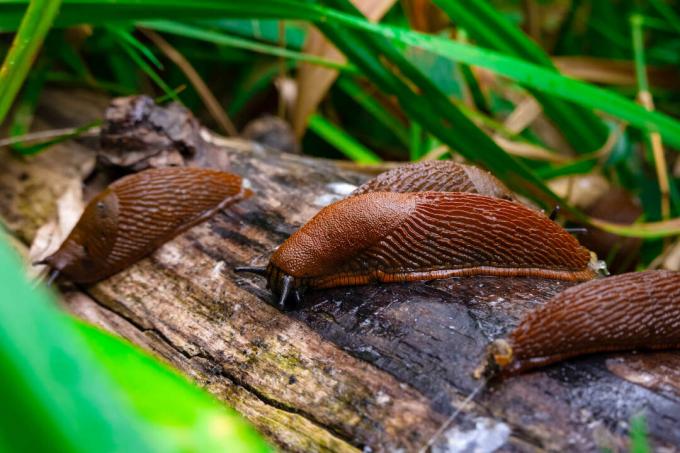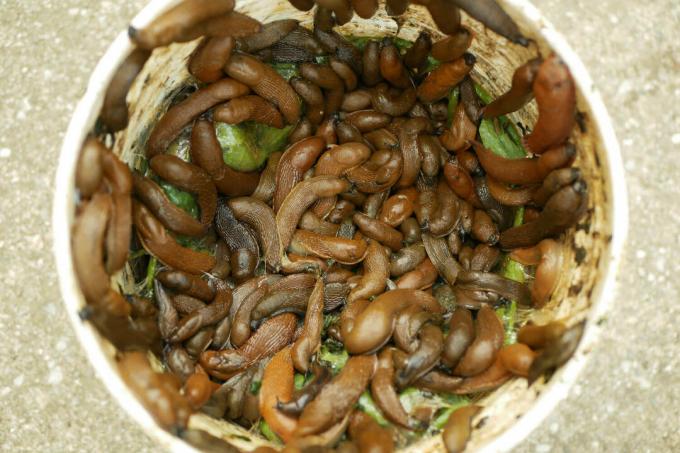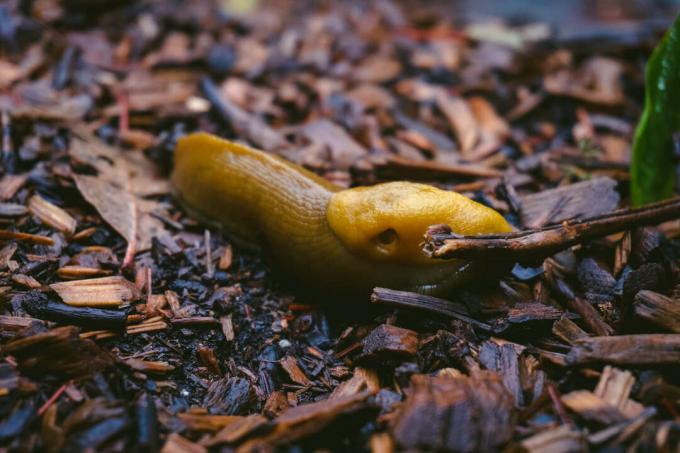Nobody likes to see slugs in their beds. Therefore, many snail traps or instructions for DIY are offered.

Nudibranchs feast with relish in the lush flower beds of hard-working gardeners. In order to get something from the harvest yourself, it is advisable to set up snail traps. It's pretty simple, especially if you know what snails like: protection from predators and from dehydration. Traps that offer these two baits work best. With some models, the snails can be collected alive, with others they perish.
tip: In the spring, snail traps are generally most effective, as the other food supply is still low here and the emergence of a large snail population is prevented.
contents
-
Snail trap: pros and cons
- Traps alive
- Poison traps
- Beer trap for snails: does it really work?
-
Build a snail trap yourself: instructions
- Dark and damp oases
- Collection container live trap
- Collection trap with slug pellets
-
Alternatives to snail traps
- Slug pellets
- Plants against snails
- Snail fences
- Promote natural enemies
- Mulch and water properly
- Fight snails in good time
Snail trap: pros and cons
Snail traps can be divided into live and poison traps.
Traps alive
Live traps aim to lure snails with fragrances or to offer them an attractive shelter. From there they can be collected and relocated to a new habitat. The problem with this is that the snails may return to you or your neighbors. On the other hand, it is positive that no animal is tortured and no beneficial insects such as snails are harmed.
However, attractants that are too strong, such as beer, only attract more of the reptiles. Cooked food could undesirably attract rats. Live traps are quick and easy to build yourself - we will explain how a little later. Since snail traps are often not very attractive, some variants can even be buried in the ground.

Poison traps
When using poison bait, snails die, which means that they are permanently eliminated. In addition, slug pellets scattered in the bed are relatively inconspicuous. However, the duration of the effect depends on the weather. Such a grain based on metaldehyde - like most conventional ones - is harmful to the environment and also endangers other animals and small children. If you want to avoid this and sluggish snails lying around in the bed, you can go to Iron-III-phosphate slug pellets To fall back on.
At a glance: advantages and disadvantages of snail traps
- Traps alive: Insensitive to the weather and self-manufacture, but no reliable screw removal
- Toxic traps with metaldehyde: Reliable control of snails, but sensitive to the weather, cannot be produced in-house and is dangerous for pets and the environment
- Poison traps with ferric phosphate: Reliable control of snails, gentle on pets and beneficial insects, insensitive to the weather, but not self-made
tip: For a 100 square meter garden you need around 20 to 30 snail traps. Places under dense bushes, perennials and ground cover, especially on the edge of the garden, should be chosen as locations where the snails like to hang out.
Beer trap for snails: does it really work?
Probably not, because beer has an extremely strong attraction on snails. You can smell the yeast in the beer from a distance of up to 200 meters. That seems practical at first. But it also attracts snails from a wide area that would otherwise not have come into the garden at all. Therefore, beer traps should be avoided.

Build a snail trap yourself: instructions
If you want to build a snail trap, you should consider the following: Slugs love it dark, damp and warm. Food is an added bonus that no snail would turn down, of course. The molluscs are best attracted with moderate attractants from parts of plants that snails like to eat. Salad, cabbage, strawberries, apples and some other fruits are effective. Kitchen scraps can be used, but nothing that has been cooked or seasoned, otherwise rats will be attracted. Ornamental plants such as marigolds and dahlias are also used. Moist wheat bran is also recommended.
Below is how to make a snail trap yourself from home remedies.
Dark and damp oases
Snails are made up of almost 90% water. It is therefore imperative that you protect yourself from dehydration. Where does that work best now? In a dark and damp place, of course! So give the slimy fellows an inviting shelter. You can do this, for example, by placing a moistened wooden board, preferably with grooves, in a shady spot. The snails will soon be there and can be removed. In a slightly sunnier place, a moistened wooden board on the floor with some space underneath can serve as a hiding place for snails. A moistened tree stump in the shade is just as attractive. The advantage of this method is that it really doesn't involve much effort or expense to create a hiding place.
tip: The entry portals into such containers should be small, only around 1 cm in diameter. In this way, as far as possible, no snails can get lost.

Collection container live trap
Live traps for snails are collecting containers into which the animals can easily and happily enter, but only with difficulty or reluctantly. Snails avoid brightness, because this is associated with predators and with solar radiation that leads to dehydration. That is why the center of the trap is dark, but the way out is getting lighter. There is therefore a clear reason for the snails to stay in the trap.
You can collect snails in different containers. A popular option is to make a snail trap out of a milk carton. To do this, rinse the box properly, remove the lid, fill in kitchen waste as described above and take it to the garden. With the opening facing up, it is best to dig it a little in the ground. Of course, other tetra packs can also be used, as well as other containers that create a damp and dark environment. The opening should be big enough for snails, but prevent larger animals from entering. It is advisable to collect the molluscs before dusk and to change the location of the trap every two to four days.
Important: Intensive attractants such as beer or brewer's yeast should be avoided at all costs, as these also attract numerous snails from far away.

Collection trap with slug pellets
Slug traps can also be equipped with slug pellets instead of kitchen scraps. Such traps are tinkered a little differently.
To prevent the slug pellets from coming into contact with the ground, the pellets can be sprinkled in crown corks, for example, and stuck on. For stability, the cork should then be glued to a base. The base with the snail corks is covered with a dark shell, as can be found in food packaging such as yogurt tubs. However, small openings have to be cut in the cup so that the snails can get inside. These should be about 1 cm in diameter - large enough that slugs, but not shell snails, can fit through. The traps are placed where the danger of snail damage is greatest: between new plantings or other particularly susceptible varieties. Bait stations should also be placed in typical habitats, for example ground cover such as cushion perennials or natural stone walls. We recommend relocating the trap after two to four days.

Alternatives to snail traps
If you don't want to set up any of the snail traps described in your garden, there are still other options available.
Slug pellets
A widely used remedy is Slug pellets. In the past, it mostly contained the active ingredient methiocarb, which, however, is no longer approved due to its environmental pollution. Another substance used is metaldehyde, which is also toxic for pets, but is kind to beneficial insects and is therefore approved for use.
Better, and even approved for organic cultivation, is the active ingredient iron-III-phosphate. Snails that ingest this drug stop eating, retreat to their hiding place and divorce there. There is no danger to other animals or people. Hence ours is also based Plantura organic slug pellets on the environmentally friendly iron (III) phosphate. Over time, this is converted into the nutritional elements iron and phosphate and is completely harmless to the soil and the environment.
You can find out what needs to be considered in detail when applying the grain in our special article about Slug pellets Experienced.
Plants against snails
There are a variety of plants that snails hate. These include herbs such as wild garlic (Allium ursinum), Real Dost (Origanum vulgare) or thyme (Thymus spec.). But also bait plants like marigolds (Tagetes) or delphinium (Delphinium spec.) keep snails away from fruit and vegetables. You can learn which plants are still helpful in our article on the subject Plants against snails.
Snail fences
Snail fences can also be used. These should be anchored at least 10 cm deep in the ground and also be 10 cm high. It is important that no parts of the plant protrude over the fence and that the snails are collected regularly, preferably every evening after the onset of dusk. Coffee grounds can be used as a further barrier. You can read about what to consider in our article Coffee grounds against snails.
Promote natural enemies
Natural predators decimate the snail infestation. These include many birds such as magpies, blackbirds and starlings, as well as hedgehogs, shrews, toads and blindworms. If you offer these animals a natural habitat, your work in crop protection will be easier. Create piles of leaves as hiding places or hedges and bushes for nesting sites.

Mulch and water properlyn
Mulch is supposed to prevent beds from drying out. However, damp wood and bark are also popular with snails. In order to keep snails out of the bed, it should therefore not be mulched. Regular watering every two to three days, and possibly more often in particularly hot weather, is more effective against snail infestation than mulch. When it comes to watering, timing is also crucial. Watering in the morning is beneficial as the soil can dry off by the evening slugs appear. So they find an area less appealing to them.

Fight snails in good time
In autumn or early spring, the next generation of snails can be prevented from growing up by killing their pin-sized eggs. Hundreds of these can be found in nests in the ground, but also under planters, moss, mulch, loose stones, between pavement slabs and in piles of leaves. Gardeners can get help from the Roman snail and the tiger snail, because they eat the eggs of other snails. The scrim can also be positioned in a sun-exposed position so that it dries up. The remains are consumed by birds and hedgehogs.

If you take care of the environment and animals, it is sometimes not that easy to practice crop protection. You get some support from the plants themselves, because the snails do not like some of them at all. You can find out which plants you can cultivate in your garden without fear of a snail infestation in our article on the subject snail-resistant plants.

